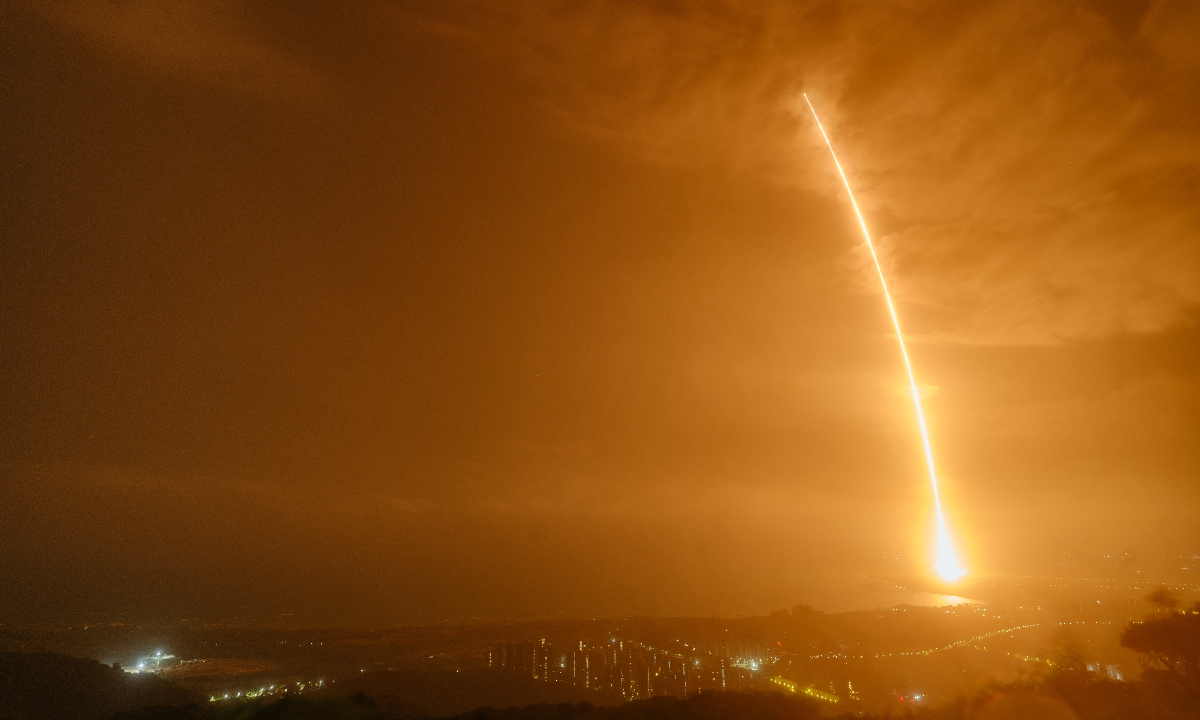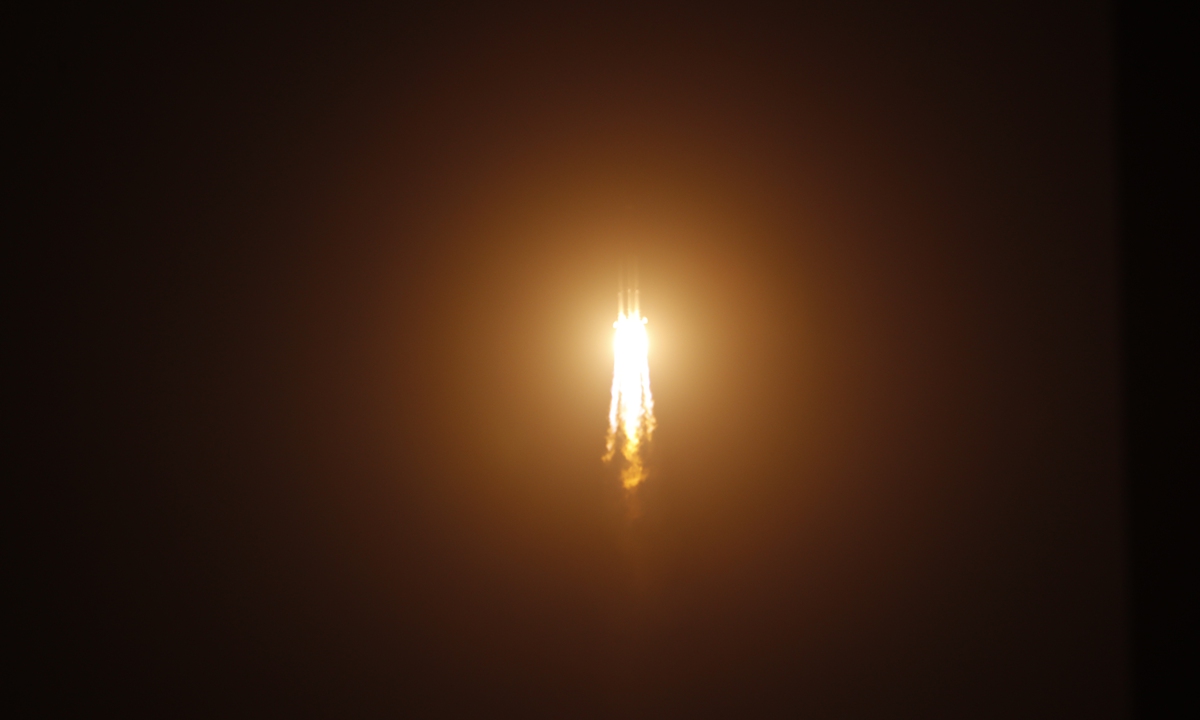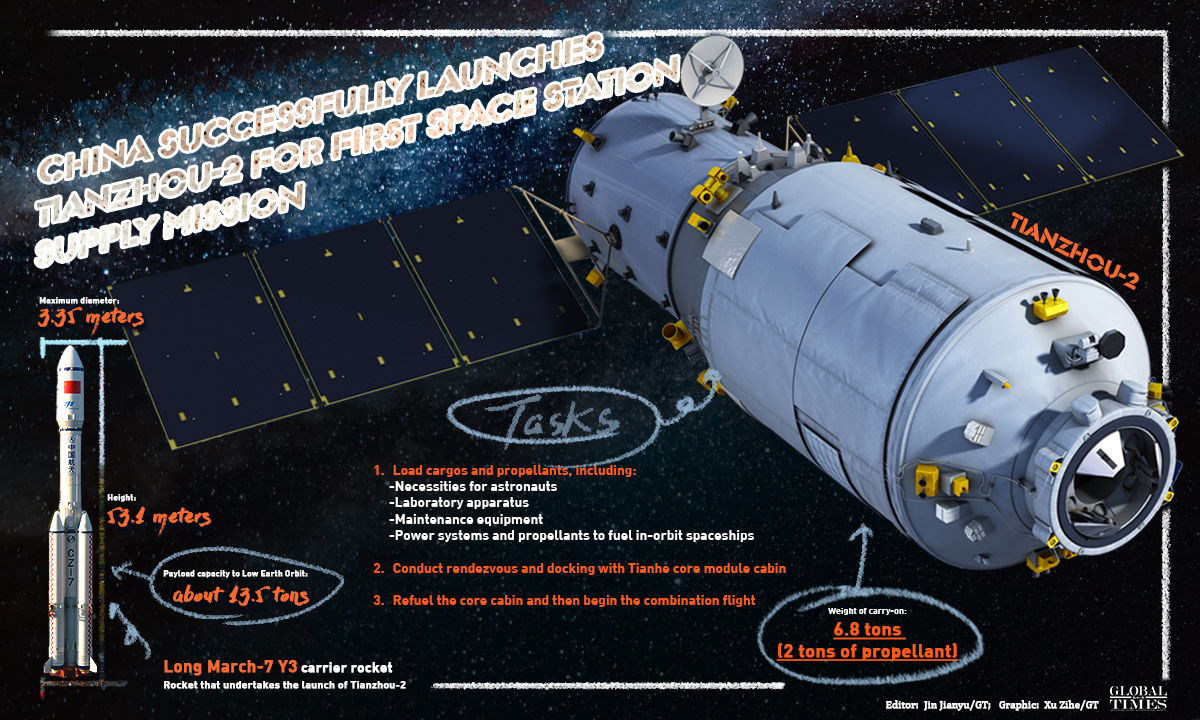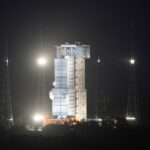China has delivered a spectacular four-peat in space within a month following the successful launch of the Tianhe core cabin, Tianwen-1’s soft-landing on Mars, and Zhurong rover kicking off its grand journey on the Red Planet after driving off the landing platform, as a Long March-7 Y3 carrier rocket took off from Wenchang spaceport on the tropical island of Hainan in South China late Saturday night, sending the Tianzhou unmanned cargo spacecraft into preset orbit for an epic space station supply mission.
At 8:55 pm on Saturday, the Long March-7 Y3 carrier rocket carrying the Tianzhou-2 cargo spacecraft took off from the Wenchang Satellite Launch Center. After a flight time of around 604 seconds, the spacecraft separated with the rocket and entered preset orbit. At 9:17 pm, the solar panels onboard the spacecraft smoothly unfolded, with all functions in normal operating condition, marking the success of the first launch of a spaceship to the space station core cabin, according to the China Manned Space Agency (CMSA.)
The Tianzhou-2 cargo spacecraft was originally slated to be launched at around 1 am on May 20 and to head to China’s Tianhe space station core cabin, which was launched into orbit on April 29, for a supply run. However, the launch was scrubbed narrowly following an announcement from CMSA on the early morning of May 20 for “technical reasons.”

China launched Tianzhou-2 cargo spacecraft for China’s space station Tianhe core cabin supply mission via a Long March-7 Y3 carrier rocket from Wenchang spaceport in Hainan Province around 9 pm Sat.Photo:Guo Wenbin
Space observers saw the postponement as a normal practice in the aerospace industry and said it showed China is not rushing into anything but keeping a steady pace, and is resolute in preventing any potential risks from going to space.
The Tianzhou cargo craft, dubbed the “delivery guy” of China’s space station, is tasked with refueling the Tianhe space station core cabin for its maintenance in orbit, conducting space scientific experiments, and also shipping living necessities for astronauts on future crewed mission at the space station, Global Times learned from the project contractors.
It will conduct rendezvous and docking with the Tianhe core module cabin, refuel its propellant and then begin the combination flight, during which a range of key technology including robotic arms’ movements will be tested.
As the first spaceship launched in the space station construction phase, Tianzhou-2 weighed 13.5 tons at launch, and is capable of sending a payload of 6.9 tons for supply missions. Its in-orbit service is at least one year, said Feng Yong, commander-in-chief of the Tianzhou-2 mission from the project contractor China Academy of Space Technology (CAST).
The 10.6-meter-long, 3.35-meter-diameter Tianzhou-2 cargo spaceship has two components – a totally enclosed cargo cabin and a propelling cabin, according to CAST.

China launched Tianzhou-2 cargo spacecraft for China’s space station Tianhe core cabin supply mission via a Long March-7 Y3 carrier rocket from Wenchang spaceport in Hainan Province around 9 pm Sat.Photo:Guo Wenbin
The carry-on onboard the Tianhe spacecraft includes consumables that are designed to support three astronauts on their space missions for three months, space suits for missions outside cabin and other supplies, Feng revealed, adding that during its docking with the space station core cabin, it will also carry out multiple in-orbit experiments.
Tianzhou-2 will also deliver propellants to refuel the Tianhe core cabin, Mu Guoxin, a CAST publicity official said.
“Next, the Shenzhou-12 manned spaceship will dock with the core cabin at the front, and altogether the three sections will form the first linear structure for China’s space station,” Mu noted.
There were 6.8 tons of supplies onboard the Tianzhou-2, including some 160 parcels of goods and two tons of propellants, according to the CAST. “The load to total mass ratio is over 50 percent, indicating its world leading capacity.”
The two space suits for the astronauts’ outside-cabin activities weigh more than 100 kilograms each, it disclosed.

Graphic:GT
Another major function of the cargo spacecraft is refueling other in-orbit components of the space station with the propellants it has carried to space. After docking with the core cabin, it will autonomously connect and inject the propellants, ensuring a stable, long-term operation of the space station, the Global Times learned from its vice chief designer Dang Rong.
The waste generated in the space station will also be stored in the Tianzhou-2 cargo spacecraft. After completing its mission and separating from the space station, the cargo spacecraft will not directly return to the ground, but instead return to a predetermined sea area along with the waste, enter the atmosphere, and then get burned off, Yang Hong, chief designer of China’s space station said during an interview with CCTV News.
It is the third flight of the 53.1-meter-long, 3.35-meter-diameter Long March-7 rocket, which is fueled by the new clean energy of liquid oxygen and kerosene.
The rocket has four 2.25-meter-diameter boosters and a weight at launch of 597 tons, and is capable of sending a payload of 13.5 tons to the low Earth orbit and of 5.5 tons to the 700-kilometer sun-synchronous orbit, the rocket’s developer the China Academy of Launch Vehicle Technology (CALT) told the Global Times.
Long March-7 made its maiden flight on June 25, 2016 from Wenchang spaceport in Hainan, and a second flight on April 20, 2017.
Designed specially for China’s manned space missions, Long March-7 went on its second mission sending the Tianzhou-1 cargo spacecraft for a successful rendezvous and docking with the Tiangong-2 space lab around two days after the launch.
Compared to the Tianzhou-1, the new version will attempt to speed up the process of rendezvous and docking with the Tianhe core module cabin, shortening it from about two days to only a few hours, the Global Times learned from mission insiders.
Tianzhou-2 has also developed skills in altitude control and course correction after it has docked with the core module.
CALT said in a statement it sent to the Global Times that the smooth execution of the Friday mission is of great importance, as it is the first spacecraft docking with the China’s space station. CALT referred to the mission as the “decisive battle” that connects the first and later construction missions of the space station.
In order to precisely send the payload of the Tianzhou cargo spacecraft to the same space orbit as the Tianhe core cabin for a smooth rendezvous, developers of the Long March-7 Y3 said they have adopted a new automatic course correction technology, enabling the rocket to overcome minor orbital deviance, if any occurs at launch or during flight, and expand the launch window from zero to some two minutes.
They also said that the design reliability of the rocket type has reached 0.98, a world leading standard. Its transfer process is able to weather a strong Force 8 gale, and it can also be launched in rain.
Apart from four cargo spacecraft launch missions in the following two years in the space station construction phase, Long March-7 will keep a mission frequency of two launches every year in the operation phase of the space station, developers revealed.
Next, the Shenzhou-12 crewed spacecraft is scheduled for launch via the Long March-2F carrier rocket in June, sending three astronauts into orbit for about three months, during which the regenerative life support system and maintenance will be tested.
An intense schedule of 11 launches has been set for the construction of China’s space station, which started on April 29 with the launch of Tianhe core cabin and will continue through 2022. China’s space station is expected to become operational by around 2022.
Graphic:GT



